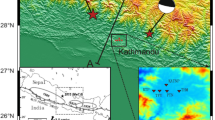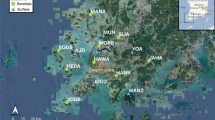Abstract
The April 20, 2013, Ms 7.0 Lushan Earthquake was a major earthquake that followed the Ms 8.0 Wenchuan Earthquake on May 12, 2008. Frequent earthquakes have caused heavy casualties and property loss in Western Sichuan. Earthquake disasters are often closely related to the amplification effect of ground motion. Studying the ground motion characteristics of near-surface geological structures helps to understand the distribution of potential earthquake disasters. In this study, we investigated ground motion amplification in the downtown area of Lushan using numerical simulation and aftershock data from the Lushan Earthquake. Using the Lushan earthquake aftershock data from nine seismic stations distributed in the area, the amplification effect of the sites was determined using the “reference site spectral ratio” method. The results show that the frequency of the ground motion amplification in the area was in the range 5–10 Hz, and the corresponding amplification peak was from 3 to 14. Among the study sites, the amplification (14 times) at L07 was the most prominent. To study further the amplification characteristics, shear-wave velocity models for the structures under these sites were established using passive-source Rayleigh surface-wave exploration. One-dimensional (1D) and two-dimensional (2D) seismic amplification effects were simulated using horizontally propagating shear-wave modeling. Except Site L07, the 1D simulation results of each site well reflected the variation feature of the seismic amplification on the frequency band below the observed peak frequency, although the overall simulated amplification peaks were smaller than the observed results. The 2D simulation of the remarkable amplification phenomenon at L07 was in better agreement with the observation result than was the 1D simulation, indicating that the seismic amplification in the Modong area is influenced by lateral variation of the Quaternary sediments.
Similar content being viewed by others
References
Abraham, J. R., Smerzini, C., Paolucci. R., et al., 2016, Numerical study on basin-edge effects in the seismic response of the Gubbio valley, Central Italy: Bulletin of Earthquake Engineering, 14(6), 437–1459.
Andreson, J. G., Lee, Y., Zeng, Y., et al., 1996, Control of strong motion by the upper 30 meters: Bulletin of the Seismological Society of America, 86(6), 1749–1759.
Bard, P. Y., and Bouchon, M., 1985, The twodimensional resonance of sediment-filled valleys: Bulletin of the Seismological Society of America, 75(2), 519–541.
Barton, N., 2006, Rock quality, seismic velocity, attenuation and anisotropy: Taylor and Francis, London, pp.721
Bohlen, T., and Saenger, E., 2006, Accuracy of heterogeneous staggered–grid finite–difference modeling of Rayleigh waves: Geophysics, 71(4), T109–T115.
Borcherdt, R. D., 1970, Effects of local geology on ground motion near San Francisco Bay: Bulletin of the Seismological Society of America, 60(1), 29–61.
Bordoni, P., Cultrera, G., Margheriti, L., et al., 2003, A microseismic study in a low seismicity area: the 2001 site-response experiment in the Città di Castello basin (Italy): Annals of Geophysics, 46(6), 1345–1360.
Bordoni, P., Del Monaco, F., Milana, G., et al., 2014, The seismic response at high frequency in central L’Aquila: a comparison between spectral ratios of 2D modeling and observations of the 2009 aftershocks: Bulletin of the Seismological Society of America, 104(3), 1374–1388.
Brocher, T. M., 2008, Compressional and shear-wave velocity versus depth relations for common rock types in Northern California: Bulletin of the Seismological Society of America, 98(2), 950–968.
Chengdu Institute of Geology, 1992, Geological map of the People’s Republic of China H48E012004 (Tianquan): National Geological Archives of China.
Civilini, F., Pancha, A., Savage, M. K., et al., 2016, Inferring shear–velocity structure of the upper 200 m using cultural ambient noise at the Ngatamariki geothermal field, Central North Island, New Zealand: Interpretation, 4(3), SJ87–SJ101.
Cruzatienza, V. M., Tago, J., Sanabriagómez, J. D., et al., 2016, Long Duration of Ground Motion in the Paradigmatic Valley of Mexico: Scientific Reports, 6(38807), 1–9.
Haines, A. J., and Yu J., 1997, Observation and synthesis of spatially-incoherent weak-motion wave-fields at Alfredton Basin, New Zealand: Bulletin of the New Zealand National Society for Earthquake Engineering, 30(1), 14–31.
Han, C., 2016, A study of seismic ground motion amplification in Lushan county: MSc thesis, Chengdu University of Technology.
Hartzell, S., Meremonte, M., Ramirezguzman, L., et al., 2014, Ground Motion in the Presence of Complex Topography: Earthquake and Ambient Noise Sources: Bulletin of the Seismological Society of America, 104(1), 451–466.
Huang, R. Q. and Yu, J., 2003, Modelling of the effects of properties of a buried weak layer on seismic waves: Journal of Engineering Geology (in Chinese), 11(3), 312–317.
Huang, R. Q., Wang, Y. S., Pei, X. J., et al., 2013, Characteristics of coseismic landslides triggered by the Lushan Ms7.0 Earthquake on the 20th of April, Sichuan Province, China: Journal of Southwest Jiaotong University (in Chinese), 48(4), 581–589.
Jamison, H. S., Alexei, G. T., and Ralph, J. A., 1996, What is a reference site: Bulletin of the Seismological Society of America, 86(6), 1733–1748.
Kawase, H., 1996, The cause of the damage belt in Kobe: “the basin-edge effect,” constructive interference of the direct S-wave with the basin-induced diffracted/ Rayleigh waves: Seismological Research Letters, 67(5), 25–34.
Keceli, A., 2012, Soil parameters which can be determined with seismic velocity: Jeofizik, 16, 17–29.
Li, Y. S., and Huang, R. Q., 2009, Earthquake damage effects of towns and reconstruction site selection in Wenchuan earthquake on May 12, 2008: Chinese Journal of Rock Mechanics and Engineering (in Chinese). 28(7), 1370–1376.
Louie, J. N., 2001, Faster, Better: Shear wave velocity to 100 meters depth from refraction microtremor arrays: Bulletin of the Seismological Society of America, 91(2), 347–364.
Maeda, T., Takemura, S., and Furumura, T., 2017, OpenSWPC: An open-source integrated parallel simulation code for modeling seismic wave propagation in 3D heterogeneous viscoelastic media: Earth Planets and Space, 69(102), 1–20.
Makra, K., Chávez, F. J., Raptakis, D., et al., 2005, Parametric analysis of the seismic response of a 2D sedimentary valley: Implications for code implementations of complex site effects: Soil Dynamics and Earthquake Engineering, 25(4), 303–312
Martino, S., Lenti, L., Gélis, C., et al., 2015, Influence of lateral heterogeneities on strong-motion shear strains: simulations in the historical center of Rome (Italy): Bulletin of the Seismological Society of America, 105(5), 2604–2624.
Molnar, S., Cassidy, J. F., and Dosso, S. E., 2004, Site response in Victoria, British Columbia, from spectral ratios and 1D modeling: Bulletin of the Seismological Society of America, 94(3), 1109–1124.
Pancha, A., Anderson, J. G., Louie, J. N., et al., 2008, Measurement of shallow shear wave velocities at a rock site using ReMi technique: Soil Dynamics and Earthquake Engineering, 28(7), 522–535.
Pancha, A., Pullammanappallil, S., Louie, J. N., et al., 2017, Determination of 3D basin shear-wave velocity structure using ambient in an urban environment: a case study from Reno, Nevada: Bulletin of the Seismological Society of America, 107(6), 3004–3022.
Pratt, T. L., Horton, J. W. Jr., Muñoz, J., et al., 2017, Amplification of earthquake ground motions in Washington DC, and implications for hazard assessments in central and eastern North America: Geophysical Research Letters, 44(12), 12150–12160.
Sei, A., and Syms, W., 1995, Dispersion analysis of numerical wave propagation and its computational consequences: Journal of Scientific Computing, 10(1), 1–10.
Semblat, J. F., Duval, A. M., and Dangla, P., 2000, Numerical analysis of seismic wave amplification in Nice (France) and comparisons with experiments: Soil Dynamics and Earthquake Engineering, 19(5), 347–362.
Semblat, J. F., Duval, A. M., and Dangla, P., 2002, Seismic site effects in a deep alluvial basin: numerical analysis by the boundary element method: Computers and Geotechnics, 29(7), 573–585.
Singh, S. K., Mena, E., and Castro, R., 1988, Some aspects of source characteristics of the 19 September 1985 Michoacán earthquake and ground motion amplification in and near Mexico City from strong motion data: Bulletin of the Seismological Society of America, 78(2), 451–477.
Trifunac, M. D., 2009, The nature of site response during earthquakes, in Schanz, T., and Iankov, R., Eds., Coupled site and soil-structure interaction effects with application to seismic risk mitigation: Springer Press, Germany, 3–31.
Wathelet, M., 2008, An improved neighborhood algorithm: parameter conditions and dynamic scaling: Geophysical Research Letters, 35, L09301.
Xia, J., Miller, R. D., and Park, C. B., 1999, Estimation of near-surface velocity by inversion of Rayleigh waves: Geophysics, 64(3), 691–700.
Xia, J., Miller, R. D., Park, C. B., et al., 2002, Comparing shear-wave velocity profiles inverted from multichannel surface wave with borehole measurements: Soil Dynamics and Earthquake Engineering, 22(3), 181–190.
Yu, J., and Haines, A. J., 2003, The choice of reference sites for seismic ground amplification analyses: Case study at Parkway, New Zealand: Bulletin of the Seismological Society of America, 93(2), 713–723.
Yu, J., and He, Z. H., 2003, Precise modelling of SH wave propagation in subsurface multi-layer media: Journal of Seismological Research (in Chinese), 26(1), 14–19.
Yu, J., Han, C., Wang, X. B., et al., 2017, Seismic ground motion amplification in Lushan downtown area: observation and analysis of aftershock data following the 4.20 Lushan Ms 7.0 earthquake: Progress in Geophysics (in Chinese), 32(3), 1071–1079.
Yu, Y., Ding, H., and Liu Q., 2018, Effects of shear-wave velocity and quality factor of the Quaternary sediment on seismic effects of the Sichuan basin during the Wenchuan earthquake: Progress in Geophysics (in Chinese), 35(5), 1862–1870.
Zhang S., Jiang C., Jiang H., et al., The April 20, 2013, Lushan, Sichuan, China, earthquake: an overview, in Wu, Z., Jiang, C., Li, X., et al., Eds., Earthquake phenomenology from the field: the April 20, 2013, Lushan earthquake: Springer Press, Singapore.
Acknowledgments
The catalogue information used in the study is from the China Seismological Network Center, and the topographic elevation data are from ASTER GDEM V2.0 data of NASA.
Author information
Authors and Affiliations
Corresponding author
Additional information
This study was supported by the National Natural Science Foundation of China (No. 41774059), and the Sichuan Science and Technology Program (No. 2018JY0005).
Han Chao is a doctoral student at College of Geophysics, Chengdu University of Technology. He received a BSc in geophysics from Chengdu University of Technology in 2013 and received a MSc in applied geophysics from Chengdu University of Technology in 2016. His main research interests are seismology and near-surface velocity structure imaging.
Rights and permissions
About this article
Cite this article
Han, C., Yu, J., Liu, WZ. et al. Numerical simulation of ground motion amplification in Modong area, Lushan. Appl. Geophys. 16, 277–290 (2019). https://doi.org/10.1007/s11770-019-0776-z
Received:
Revised:
Published:
Issue Date:
DOI: https://doi.org/10.1007/s11770-019-0776-z




